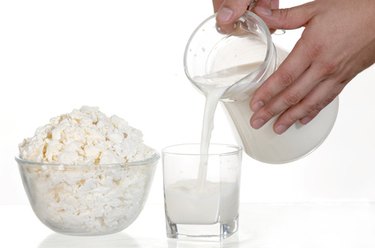
Different types of laundry stains require different stain removal tactics. Not only is stain removal easier if you use the proper cleaning procedure, but cleaning a stain the wrong way can set the stain permanently. Although you may not remove all stains, you'll have a better chance of success if you first identify which type of stain you're dealing with.
Protein
Video of the Day
Protein stains are stains that come from an animal-based product. These include food items, such as gelatin, eggs and dairy products (including milk, cheese sauce and ice cream). Other protein stains come from urine, feces, blood, vomit, mud and white school glue. Remove protein stains by first scraping or removing as much of the solid as possible. Rinse the area under cold water, and apply a liquid laundry detergent to the stain. Allow the laundry detergent to soak in, and wash the garment in cold water. Do not wash the garment in hot water until all of the protein stain has been removed as hot water will set a protein stain permanently.
Video of the Day
Oil
Oil-based laundry stains come from plant or animal oils as well as automotive oil. Examples of oil laundry stains include cooking oil, bacon fat, mayonnaise, butter, lard, hand lotion, suntan oil or lotion, salad dressing, cosmetics and deodorant. Remove oil-based stains by presoaking the stain in a liquid laundry detergent and washing the garment in hot water. A laundry spot-treatment cleaner for oil stains can be very effective in removing these stains. Check the garment to ensure that the stain has been removed before drying the garment as drying the garment in a clothes dryer sets the stain. Repeat the presoaking and washing, if needed, before drying the garment.
Tannin
Tannin stains include beer, wine, cologne, tea, coffee, cola drinks, tomato juice, fruit juices made from real berries, felt-tip watercolor markers and washable ink. Do not use soaps on tannin stains as soap will set the stain. This warning includes bar soaps as well as some soap-based detergents. Check your laundry detergent to ensure it does not include soap before using it on a tannin stain. To remove a tannin stain, rinse the stain with cold water, and wash the garment in hot water. If the stain remains, apply a nonsoap pretreatment detergent, and allow it to soak for 30 minutes before washing in hot water.
Dye
Dye stains come from things such as mustard, children's juice drinks, jelly, grass, inks and felt-tip pens. Most dye stains require pretreatment. Rub a pretreatment detergent into the stain, and wash with hot water. You may need to soak color-safe garments in a color-safe bleach to remove all of the dye stain.
Combination
Combination stains, as the name implies, are made of more than one type of stain. Examples of things that cause combination stains are tomato sauce, crayons, ketchup, gravy, shoe polish, floor wax, chocolate and candle wax. Treat the stain as an oil stain first, and clean it to remove the dye.